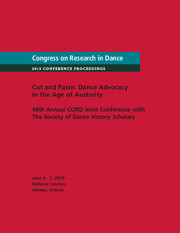No CrossRef data available.
Article contents
Rewriting Skolt Sámi Dance History
Published online by Cambridge University Press: 17 September 2015
Abstract
The paper examines the role of traditional couple and group dances of the Skolt Sámi in negotiating their history and identity. The research is based on archival and literal material from Finnish folklore archives as well as ethnographic fieldwork among the Skolts in 2014. It is addressed that the Skolts, despite their dramatic history, have been able to revive and preserve their dance traditions in many ways, and today they are reflecting their dance history from new perspectives, rewriting it and integrating it to their contemporary hybrid identities. Having lived between many different cultures for centuries, their identities are characterized by many points in their social and personal histories, and dancing is a part of the routes they have traveled within these experiences. Today, dancing provides them a strategy to negotiate both with their history and identity in contemporary society.
- Type
- Research Article
- Information
- Copyright
- Copyright © Petri Hoppu 2015


